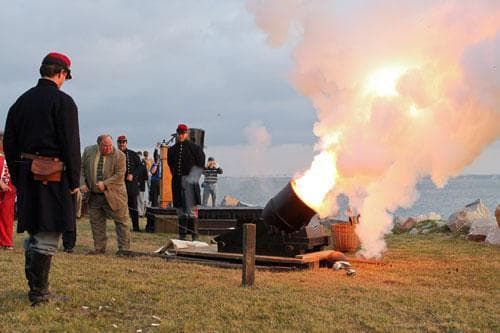Advertisement
The American Civil War 150 Years On
ResumeOn the 150th anniversary of the firing on Fort Sumter, we’ll look at the unfinished examination of the American Civil War.

Pre-dawn cannon fire this morning over Charleston Harbor in South Carolina this morning, re-enacting the 1861 firing on Fort Sumter and the beginning of the Civil War, 150 years ago today.
The sesquicentennial of the War Between the States is reviving again the country’s unending meditation on what happened in that devastating war, and why.
More than 600,000 Americans dead. America’s deadliest war. My guest today, historian David Goldfield, says the passions that drove the country then are still with us today.
This hour On Point: the Civil War’s beginning, at one hundred and fifty.
- Tom Ashbrook
Guest:
David Goldfield, professor of history at the University of North Carolina at Charlotte. His new book is "America Aflame: How The Civil War Created A Nation."
Excerpt
America Aflame: How The Civil War Created a Nation
By David Goldfield
Can anyone saying anything new about the Civil War? In this book, the outcome of the conflict will be the same as in every other book on the war. That goes for the battles, too. My main concerns are how we got into the war, how the war transformed the men who fought, and how America came out of the war. These are also the itineraries of countless other authors. I hope, however, that my treatment of the war’s origins, the conflict itself, and its aftermath will enable readers to view the Civil War from a new perspective. After the Revolutionary War, the Civil War is the defining event of American history. The Civil War not only tells us a great deal about Americans at that time, but it offers numerous insights of our nation today.
The Civil War was both the completion of the American Revolution and the beginning of a modern nation. The war proved America’s resilience. If nothing else, holding a presidential election in the midst of the Civil War, as the Union did in 1864, was a testament to that strength. The war also transformed America in ways prefigured in the antebellum years, but recognizable only after the nation went through the fire.
The Civil War is also America’s greatest failure. The political system could not contain the passions stoked by the infusion of evangelical Christianity into the political process. Westward expansion, sectarian conflict, and above all slavery assumed moral dimensions that confounded political solutions. Violence became an acceptable alternative because it worked. It put the Catholics in their proper place and away from Protestant girls. It worked against the Native Americans and against the Mexicans. And it worked against the slaveholders. Antebellum America was a turbulent place – in cities, on the frontier, and at the ballot box. The violence took its toll. Gradually, the bonds of Union fell away: the national church polities, the national political parties, and the moderate politicians disappeared.
War was not inevitable. But the prevailing political culture made it difficult to solve issues peaceably. The failure is evident in the deaths of over 650,000 young men, the misery of their families and friends left to mourn their loss, the destruction of homes and personal property, the uprooting of households, and the scenes of war haunting those who managed to live through it. Without gainsaying the individual heroism of those who fought and died, it would have been a greater tribute to our nation had they lived.
This program aired on April 12, 2011.